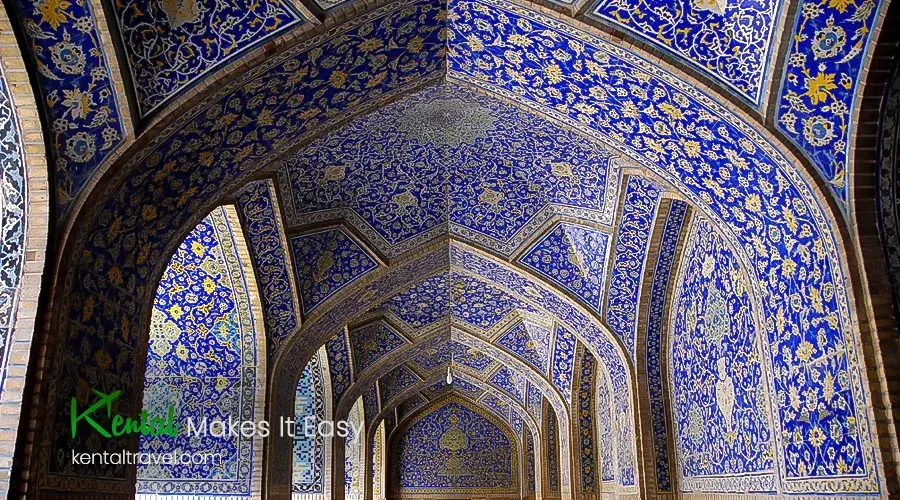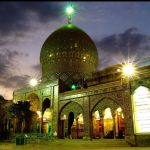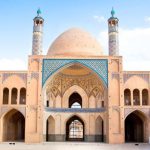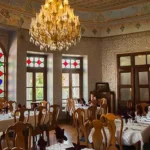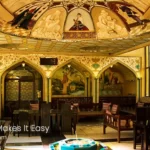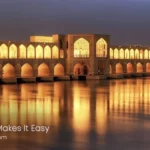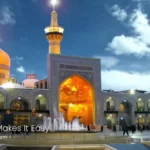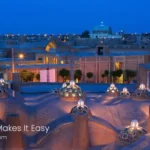The Masjed-e Jāmé of Isfahan Iran, located in the enchanting city of Isfahan, Iran, stands as a masterpiece of Islamic architecture and a testament to the rich history of the region. With origins tracing back to the 8th century, the mosque has undergone numerous expansions and renovations over the centuries, resulting in a captivating blend of architectural styles from various eras. Its immense courtyard, adorned with intricate geometric patterns, and its stunning double-shelled dome exemplify the remarkable craftsmanship of Persian artisans. The Jameh Mosque in Isfahan not only serves as a place of worship but also as a living museum, offering visitors a captivating journey through the evolution of Islamic architectural aesthetics in one of the most culturally significant cities in the world.
Where is Jameh Mosque in Isfahan?

The Masjed-e Jameh Isfahan Iran is situated in the heart of Isfahan, Iran, gracing the bustling expanse of the city’s historic center. Its strategic location at the crossroads of the city’s bustling main bazaar and the flowing Zayandehrud River, allows it to be an integral part of Isfahan’s urban fabric. This central location not only underscores the mosque’s architectural significance but also its role as a cultural hub where the spiritual and commercial aspects of the city converge.
History of Jameh Mosque of Isfahan
The history of the Jameh mosque in Isfahan is a captivating journey through time, reflecting the evolution of Islamic architecture and the city itself. Its origins can be traced back to the 8th century, during the early Islamic era, when a modest mosque was constructed on the site. Over the centuries, the mosque underwent numerous expansions, renovations, and additions, each layer adding to its grandeur and complexity. The mosque’s architectural evolution mirrors the shifting artistic and cultural influences of various dynasties, from the Seljuks to the Safavids. The intricate tile work, mesmerizing geometric patterns, and towering minarets that adorn the mosque today are the result of these successive transformations.
Masjed-e Jame on UNESCO’s World Heritage List

Masjed-e Jāmé (Jameh Mosque) of Isfahan was inscribed on UNESCO’s World Heritage List in 2012 in recognition of its outstanding cultural value and historical significance. This architectural marvel stands as a testament to the evolution of Islamic architecture over centuries, showcasing a harmonious blend of various styles and periods. Its inclusion on the World Heritage List highlights its role as a representative example of Iran’s rich cultural heritage and its contribution to the global understanding of Islamic architectural achievements.
Architect of Masjed-e Jame

The architecture of Masjed-e Jāmé of Isfahan (Jameh mosque) is a remarkable amalgamation of diverse styles and periods, showcasing the evolution of Islamic architectural aesthetics. The mosque’s structure is characterized by its intricate geometric patterns, ornate tile work, and meticulous attention to detail. Its vast courtyard, flanked by elegant arcades, provides a tranquil space for congregational prayers. The mosque features a variety of architectural elements such as domes, minarets, and vaulted chambers, each contributing to its overall grandeur. Some of the architectural features of the mosque include:
- Creation of various decorative brick arches with geometric patterns.
- Brick columns with different sections, including two-part, three-part, and four-part forms that result from combining circles.
- Vaults and covered fountains in various construction methods.
- Four iwans (vaulted halls) with distinct decorations in each.
- Grand domes with innovative methods, designed as continuous double-shelled structures.
- Balanced and ornamented facades around the courtyard.
The careful integration of different architectural elements from various historical periods reflects the mosque’s significance as a cultural and artistic crossroads. This architectural ensemble serves as a valuable source of insight into the development of Islamic architecture in the region.Conclusion
Masjed-e Jāmé of Isfahan is more than a religious site; it’s an emblem of Iran’s cultural identity. Its central location, historical significance, and UNESCO recognition emphasize its role as an architectural marvel. As we explore its diverse sections and consider its unique attributes, we gain insight into the mosque’s evolution and its representation of Iran’s rich history
The Sections of Masjed-e Jāmé of Isfahan

Basically, the current structure of Jame Mosque of Isfahan includes the following sections:
- Prayer Hall (Shabestan)
The mosque’s prayer hall dates back to the era of the Buyids. It’s supported by round columns adorned with intricate plasterwork designs. - Southern Dome
The dome and the forty surrounding columns were built between 1083 and 1105 AH (1655 to 1693 CE) and are located in the southern courtyard. The brick dome’s front porch was constructed in the early 6th century AH. This dome boasts some of the most beautiful decorative patterns made from brick and plaster. - Northern Dome
The northern dome is situated in the northern section of the mosque’s courtyard and was constructed in 1102 AH (1691 CE). It was built by Abolghasem Taj al-Molk, a minister during the Seljuk period. - Iwan-e Darvish
Iwan-e Darvish was built in the 6th century AH and features plaster inscriptions from the Safavid era. The northern side of the Iwan and its adjacent sides are adorned with forty columns from the 6th century AH, each displaying various brick designs and decorative motifs, adding to the appeal of this grand historic structure. - Iwan-e Sahab
The Iwan-ye Sahab was built during the Seljuk period and features decorations from the Qara Qoyunlu and Safavid eras. Various inscriptions from different periods, including the Safavids, are noticeable in this area. - Iwan-e Ostād
Iwan-e Ostād dates back to the Seljuk era and was embellished with tilework during the Safavid period. In this Iwan, there are Thuluth and Nastaliq inscriptions dating back to 1112 AH (1700 CE) during the reign of Shah Sultan Hussein. - Iwan-e Shāgerd
This Iwan was built during the Seljuk era and was adorned with muqarnas during the Ilkhanid and Safavid periods. In this Iwan, there is a single piece of precious marble that catches the eye, surrounded by panels and inscriptions. - Iwan-e Omr
Iwan-e Omr is situated at the eastern end of the Grand Mosque. The ceiling of this Iwan features decorative and historical lines with religious phrases written in monumental script. - Al-Jāytū Mosque
North of the Iwan-e Ostād, there is the Al-Jāytū Mosque, a small prayer hall. This mosque contains a mihrab that shines like a brilliant gem of Iranian art on the world stage, boasting immense popularity. - Khāje Nazam al-Mulk Library
The grand and renowned library of Khāje Nazam al-Mulk was destroyed during the bombardment of Isfahan, but it was reconstructed in its original style. This magnificent masterpiece held great significance due to its diverse collection spanning various Islamic periods in terms of technical and artistic achievement. Its reputation annually attracted countless groups of enthusiasts and researchers.

FAQs about Masjed-e Jame
- What is unique about the Great Mosque of Isfahan?
The uniqueness of Masjed-e Jāmé of Isfahan lies in its multifaceted architectural evolution. It encapsulates the historical transitions and contributions of various dynasties, offering a tangible representation of Iran’s cultural diversity and resilience. - Why is The Great Mosque of Isfahan significant today?
The mosque serves as a religious and cultural hub, reflecting the continuity of tradition and the interplay between architecture and society. It’s a testament to the resilience of heritage amidst the modern world’s transformations. - How has Masjed-e Jāmé influenced architectural trends?
Masjed-e Jāmé’s architectural elements, such as the intricacies of its tilework and the harmonious integration of different sections, have inspired architects globally. Its influence is particularly noticeable in Islamic architecture, where echoes of its design principles can be observed. - What are the visiting hours of Isfahan’s Grand Mosque?
You can visit Isfahan’s Grand Mosque every day. The visiting hours for the mosque are from 9 AM to 11 AM in the morning session, and from 1 PM to 4 PM in the afternoon session. - Where is the Great Mosque of Isfahan located?
Isfahan’s Grand Mosque is situated at Qiam Square, on Allameh Majlesi Street. - What are the hotels located near Isfahan’s Grand Mosque?
Hasht Behesht Hotel
Abbasi Hotel
Safavi Hotel
Isfahan Star Hotel

